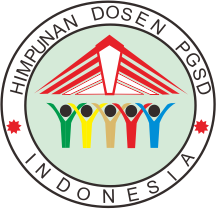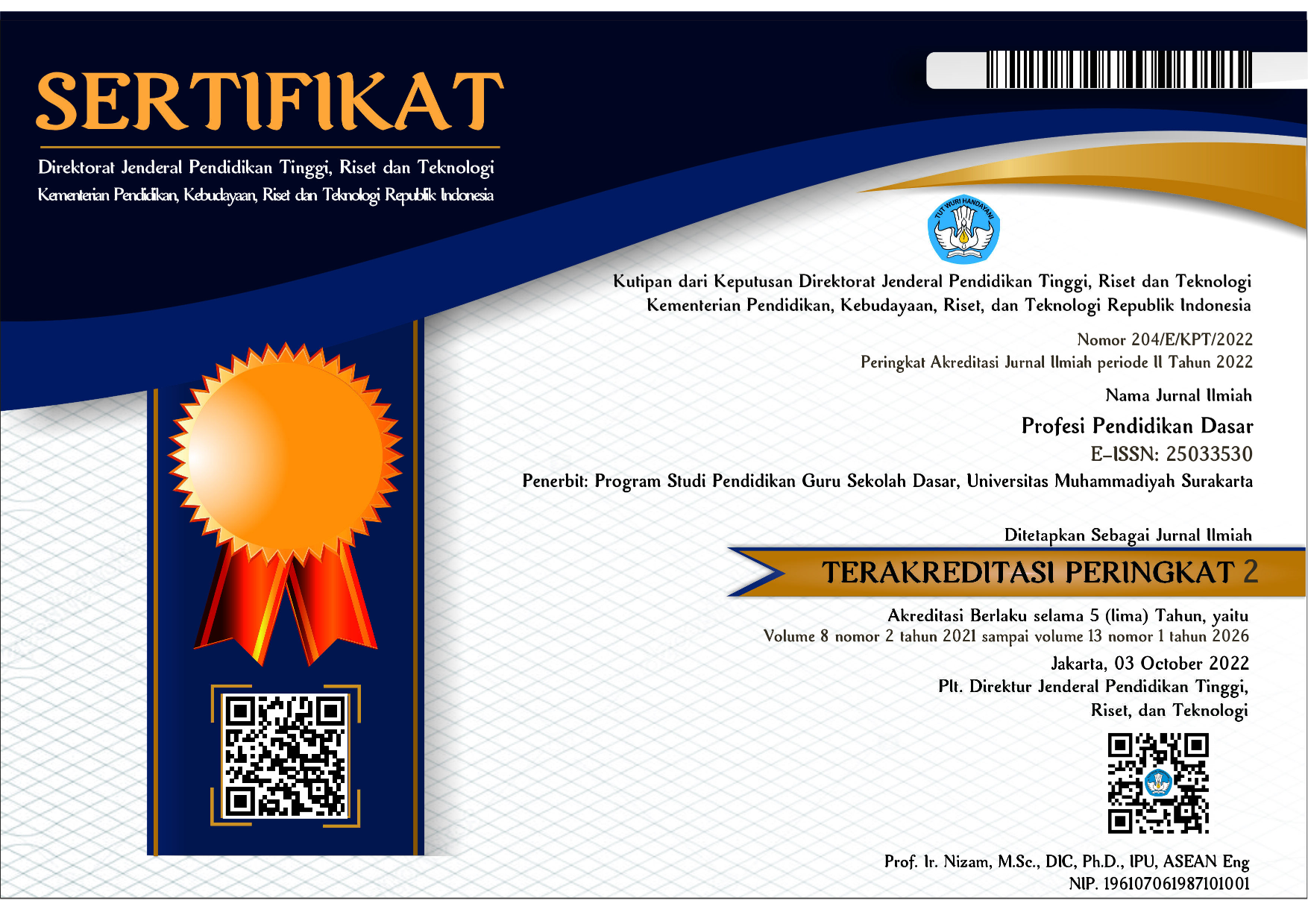Android Educational Game “MATHOLIC” Based on Van Hiele’s Geometric Thinking Level on Plane Figures
Windu Wiyana(1), Yuniawatika Yuniawatika(2*), Tri Murti(3), Mohamad Waluyo(4)(1) Universitas Negeri Malang
(2) Universitas Negeri Malang
(3) Universitas Negeri Malang
(4) University of Szeged
(*) Corresponding Author
Abstract
The objective of this study was to produce an educational game based on Van Hiele’s geometric thinking level called “MATHOLIC” on plane figures material in fourth-grade elementary school. This research was Research and Development (R&D), which used the ADDIE model. The subjects of this study were fourth-grade students of Tlumpu Blitar State Elementary School. The data collection instruments were interview guidelines and questionnaires. The data was obtained in the form of qualitative data and quantitative data. The results of this study showed that: (1) the material experts gave the level validity of MATHOLIC 95,8%, while media experts gave the validity level of MATHOLIC 94,4%, and the classroom teacher gave the level validity of 98%, which meant that MATHOLIC was very valid; (2 )student responses in small group trials obtained a percentage of the practicality was 95% and in the field trial was 97,7% which meant that MATHOLIC was very practice; (3) the average score was 87,7 in the small group trial and 96,4 in the field trial which meant that the average was already above the Minimum Completeness Criteria score. MATHOLIC was declared valid and practical to be suitably used in learning mathematics. This study showed the validity and practicality of learning media in educational games that use van Hiele's theory. The findings of this study will be a solution for teachers who have difficulty teaching the material of plane figures to make it more effective and easily understood.
Keywords
Full Text:
PDFReferences
Akbar, S. (2015). Instrumen Perangkat Pembelajaran. PT Remaja Rosdakarya.
Amalia, N. I., Yuniawatika, T. M., & Murti, T. (2020). Pengembangan E-Booklet Berbasis Karakter Kemandirian dan Tanggung Jawab Melalui Aplikasi Edmodo pada Materi Bangun Datar. Jurnal Kajian Teknologi Pendidikan, 3(3), 282–291. http://dx.doi.org/10.17977/um038v3i32020p282.
Amanda, D. A. (2019). Pengambangan Game Edukasi pada Mata Pelajaran Matematika Materi Bangun Datar Berbasis Android di SDN 1 Jepun. JoEICT (Journal of Education And ICT), 3(2). https://doi.org/10.29100/joeict.v3i2.1241
Andini, S., Fitriana, L., & Budiyono. (2018). Elementary school students visual spatial comprehension based on van Hiele Theory: The case in Madiun, East Java, Indonesia. Journal of Physics: Conference Series, 983, 012097. https://doi.org/10.1088/1742-6596/983/1/012097.
Anugrahini, M. Y. (2017). Pengembangan Game Bubble Match Sebagai Media Pembelajaran Pembagian Dalam Bentuk Pengurangan Berulang Untuk Siswa Kelas 2 SD. Profesi Pendidikan Dasar, 4(1), 75–83. 10.23917/ppd.v1i1.3975
Amaliyah AR, R., & Mahmud, N. (2018). Analisis kemampuan representasi matematis dalam pemecahan masalah geometri serta faktor-faktor yang mempengaruhinya. Jurnal Review Pembelajaran Matematika, 3(2), 146–160. https://doi.org/10.15642/jrpm.2018.3.2.146-160.
Arifin, N. N., Nura’eni, E., & Pranata, O. H. (2014). Peningkatan pemahaman siswa terhadap materi geometri melalui pembelajaran berbasis teori van hiele. PEDADIDAKTIKA: Jurnal Ilmiah Pendidikan Guru Sekolah Dasar, 1(2), 96–102. https://ejournal.upi.edu/index.php/pedadidaktika/article/view/4935.
Badjeber, R., & Suciati, I. (2021). Penggunaan metode permainan “bingo matematika” pada materi bangun datar. Aksioma, 10(1), 1–11. https://doi.org/10.22487/aksioma.v10i1.830.
Chasanah, U., Nugraheni, A. S., & Hanapi, M. H. M. (2021). Development of length measurement materials using adobe after effects. Profesi Pendidikan Dasar, 8(2), 144–155. https://doi.org/10.23917/ppd.v8i2.13384
Crowley, M. L. (1987). The Van Hiele Model of The Development Of Geometric Thought. Learning and Teaching Geometry, K-12, 1–16.
Dienes, Z. P. (1971). An Example of The Passage From The Concrete to The Manipulation of Formal Systems. In The Teaching of Geometry at the Pre-College Level (pp. 61–76). Springer. https://doi.org/10.1007/978-94-017-5896-3_7.
Dillon, T. (2005). Adventure Games for Learning And Storytelling. UK, Futurelab Prototype Context Paper, Adventure Author.
Fauzi, I., & Arisetyawan, A. (2020). Analisis Kesulitan Belajar Siswa pada Materi Geometri di Sekolah Dasar. Kreano, Jurnal Matematika Kreatif-Inovatif, 11(1), 27–35. https://doi.org/10.15294/kreano.v11i1.20726.
Fuys, D. (1984). English Translation of Selected Writings of Dina van Hiele-Geldof and Pierre M. van Hiele.
Huzaifah, E. (2011). Upaya meningkatkan pemahaman konsep geometri siswa dengan menggunakan teori van hiele [Undergraduate Thesis, Jakarta Islamic State University]. https://repository.uinjkt.ac.id/dspace/handle/123456789/5472.
Juanti, S., Karolina, R., & Zanthy, L. S. (2021). Analisis Kesulitan dalam Menyelesaikan Soal Geometri Pokok Bahasan Bangun Ruang Sisi Datar. JPMI (Jurnal Pembelajaran Matematika Inovatif), 4(2), 239–248. http://dx.doi.org/10.22460/jpmi.v4i2.p%25p.
Karim, A., & Savitri, D. (2020). Pengembangan Media Pembelajaran Matematika Berbasis Android di Kelas 4 Sekolah Dasar. Jurnal Lebesgue: Jurnal Ilmiah Pendidikan Matematika, Matematika Dan Statistika, 1(2), 63–75. https://doi.org/10.46306/lb.v1i2.17.
Indonesian Ministry of Education and Culture. (2016). Salinan Lampiran Permendikbud No. 22 Tahun 2016 tentang Standar Proses Pendidikan Dasar dan Menengah. Jakarta: Ministry of Education and Culture of Indonesia.
Kumalasani, M. P. (2018). Kepraktisan Penggunaan Multimedia Interaktif pada Pembelajaran Tematik Kelas IV SD. Jurnal Bidang Pendidikan Dasar, 2(1A), 1–11. https://doi.org/10.21067/jbpd.v2i1A.2345.
Maharani, N. (2018). Aplikasi game pembelajaran huruf alfabet untuk anak disleksia ringan [Undergraduate Thesis, 17 Agustus 1945 Surabaya]. http://repository.untag-sby.ac.id/1755/.
Munggaran, R. (2012). Pemanfaatan open source software pendidikan oleh mahasiswa dalam rangka implementasi undang- undang no. 19 tahun 2002 tentang hak cipta intellectual property rights [Undergraduate Thesis, Universitas Pendidikan Indonesia]. http://repository.upi.edu/9024/.
Simbolon, S., & Sapri, S. (2022). Analisis kesulitan belajar siswa kelas IV materi bangun datar di sekolah dasar. EDUKATIF : JURNAL ILMU PENDIDIKAN, 4(2), 2510–2515. https://doi.org/10.31004/edukatif.v4i2.2081.
Pramadana, T. I., Soro, S., & Siswanto, R. D. (2018). Pengembangan Aplikasi Bangun Datar Sederhana (Bandara) Matematika Berbasis Android Pada Materi Bangun Datar Sederhana di Tingkat SMP. Prosiding Seminar Nasional Teknoka, 3, I13–I16. https://doi.org/10.22236/teknoka.v3i0.2894.
Rayanto, Y. H., Supriyo, S., & Sugianti. (2020). Applying Objectivist Instructional Design of ADDIE Model on Learning Reading Comprehension. 795–799. https://doi.org/10.2991/assehr.k.201017.175.
Saputro, B. (2017). Manajemen Penelitian Pengembangan (Research & Development) bagi Penyusun Tesis dan Disertasi. Aswaja Pressindo.
Sappaile, B. I. (2007). Konsep instrumen penelitian pendidikan. Jurnal Pendidikan dan Kebudayaan, 13(66), 379–391. https://doi.org/10.24832/jpnk.v13i66.356.
Sholikhah, O. H., & Pradana, L. N. (2018). Virtual Mathematics Kits (VMK): Mempromosikan Media Digital dalam Literasi Matematika. Profesi Pendidikan Dasar, 5(2), 147–154. 10.23917/ppd.v1i2.6717.
Silveira, I. F., & Villalba-Condori, K. O. (2018). An open perspective for educational games. Journal of Information Technology Research (JITR), 11(1), 18–28. https://doi.org/10.4018/JITR.2018010102.
Sugiyono. (2016). Metode Penelitian Kuantitatif, Kualitatif, dan R&D. Alfabeta.
Sutriani, L., Pranata, O. H., & Suryana, Y. (2018). Implementasi teori belajar van hiele untuk meningkatkan pemahaman siswa pada konsep sifat-sifat bangun datar sederhana. PEDADIDAKTIKA: Jurnal Ilmiah Pendidikan Guru Sekolah Dasar, 5(4), 99–110. https://ejournal.upi.edu/index.php/pedadidaktika/article/view/12643.
Wati, I. F. (2020). Digital Game-Based Learning as A Solution to Fun Learning Challenges During the Covid-19 Pandemic. 1st International Conference on Information Technology and Education (ICITE 2020), 202–210. https://doi.org/10.2991/assehr.k.201214.237.
Yuniawatika, Y., Yuspriyati, D. N., Sani, I., & Febriyanti, F. (2016). Perkembangan pendidikan matematika realistik indonesia (Pmri) di lptk bandung raya. Mosharafa: Jurnal Pendidikan Matematika, 5(3), 233–246. https://doi.org/10.31980/mosharafa.v5i3.279
Article Metrics
Abstract view(s): 404 time(s)PDF: 285 time(s)
Refbacks
- There are currently no refbacks.


















